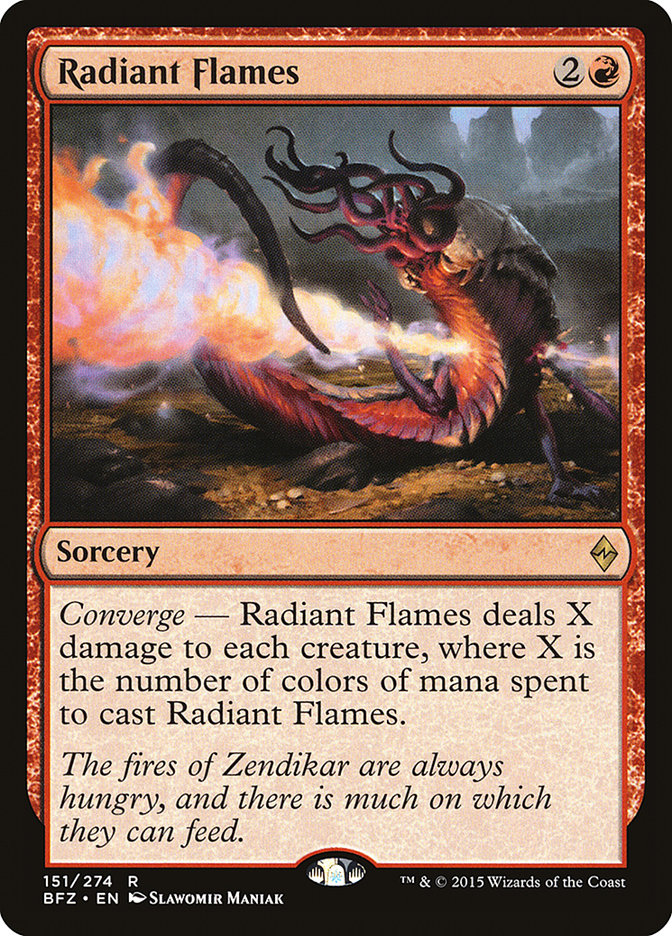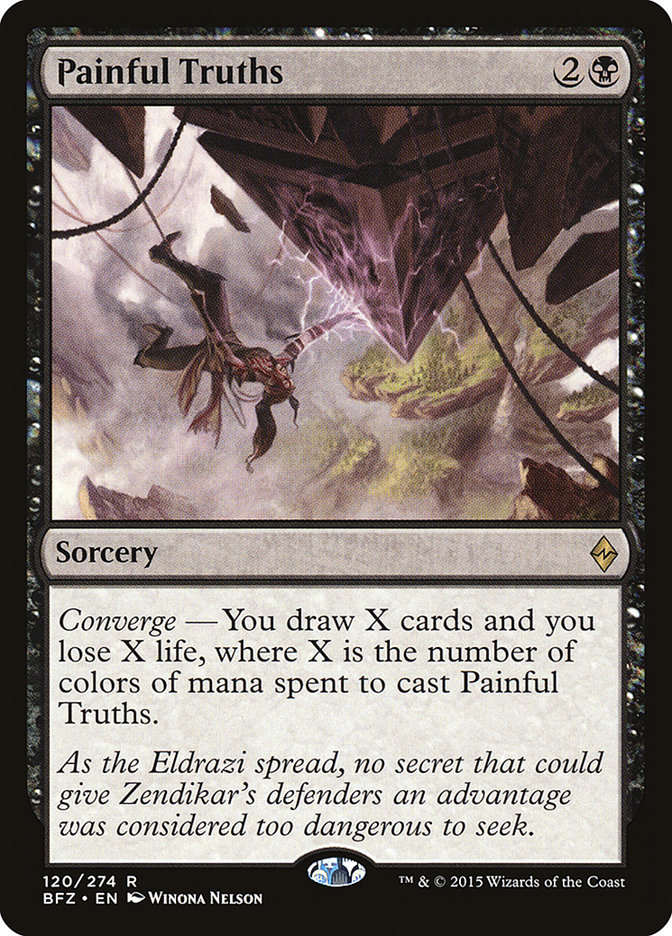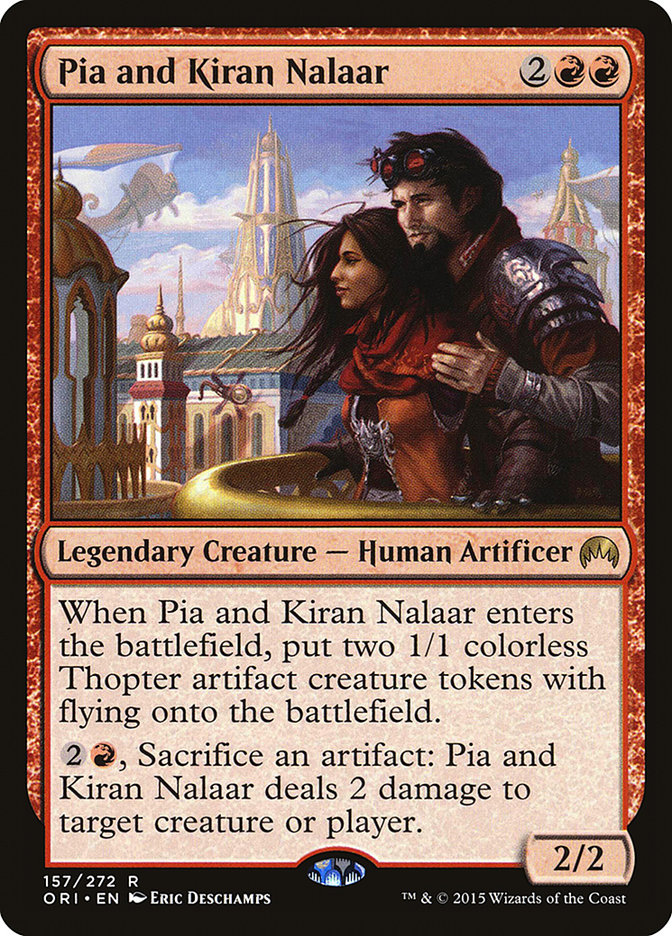“What did you play in the Pro Tour?”
“Mardu Dragons.”
“What in the world? How did that happen?”
Let’s get one thing out of the way first:
A lot of people asked me why I didn’t play G/W Megamorph at a Pro Tour where G/W Megamorph was widely believed to be one of the most powerful decks. After
all, the deck that Michael Majors played to a second place finish at #SCGINDY and went on to take both first and second at #SCGATL was clearly a descendent
of my Pro Tour Magic Origins list and obviously very much in my wheelhouse.
But the fact that the deck was so popular and understood to be powerful was exactly why I didn’t want to play it. If there was any deck at the Pro Tour
that people were sure to have prepared for in their testing, it was G/W Megamorph. Even if the deck were very strong – and I certainly believed that to be
the case – playing G/W Megamorph was just asking to play against people who specifically designed their decks to beat yours, and that’s not a position I
like to be in at a major event.
My general philosophy is that I prefer not to play whatever is considered the “deck to beat” going into an event, because I’d rather have my opponents be
less prepared to play against me. In some cases, the “best deck” is so good that even opponents who are trying to beat you can’t really do it, but most of
the time – especially early in a format, and especially with a deck as straightforward as G/W Megamorph – the most talked-about deck leading into an event
is rarely the one that performs the best.
Going into the Pro Tour, it seemed clear that the most popular decks were going to be G/W Megamorph, Jeskai, and Red Aggro. Rather than play any one of
them, I wanted to try to find something that beat all of them. Easy enough, right? Maybe not, it turns out.
My testing for the Pro Tour did not begin in earnest until the Monday prior to the event, since I was in San Francisco the previous weekend to do
commentary for the Hearthstone Americas Championship. I booked an ultra-early flight out on Monday morning to get me to Milwaukee as soon as possible, only
to find out too late to change it that the house my team had rented to test was actually near Madison instead. Because I’d lost my driver’s license in Las
Vegas during my bachelor party a while back and hadn’t had time to get a new one from at DMW, I was unable to rent a car and ended up taking an extremely
expensive Uber for the two hour drive.
My earliest ideas that I wanted to try were all based around the apparent strength of Radiant Flames. All three of G/W Megamorph, Jeskai, and Atarka Red
played a significant number of small creatures that were vulnerable to the sweeper. It felt like a deck that could effectively leverage Radiant Flames,
especially in the maindeck, would be well-positioned to compete with all of them effectively.
The biggest problem with building around a card like Radiant Flames is that the card is inherently a reactive one. It’s not really a gameplan, per se, but
rather just a powerful card in situations when your opponent has multiple small creatures. It also happens to be a symmetrical effect, so playing with
Radiant Flames inherently has certain implications on the kind of cards you can effectively include in your own deck.
The direction I went down was to try building a Temur based deck that used creatures that survive Radiant Flames, like Savage Knuckleblade, Thunderbreak
Regent, and Woodland Wanderer, so you could proactively develop your board with big threats and then wipe up your opponent’s team with Radiant Flames to
finish them off.
The biggest problem with the deck was the lack of quality two- and three-drops that actually fit with the gameplan. Playing a bunch of four-drops made the
deck want mana creatures like Rattleclaw Mystic and Beastcaller Savant, but those don’t mesh very well with Radiant Flames. I wanted to use Scaleguard
Sentinels, since they can become 3/4 with their trigger, but it was hard to play either enough Dragons to consistently activate them or a manabase that
could easily support GG on turn 2 that could hope to cast Thunderbreak Regent on turn 4 as well. Similarly, one of my early ideas was to use Orator of
Ojutai as an early defensive creature that also survived Radiant Flames, but it was extremely difficult to make a manabase that could support it and
actually cast all of the Dragons I’d need to support it.
I went through a ton of iterations of the deck in the three or so days that I had to playtest, and felt like there might have been something there if I’d
had more time. Ultimately, the more I played, the more I moved away from the Radiant Flames plan that got me going down that road in the first place. The
deck felt like it needed more things to do early, and I found myself cutting reactive cards for mana creatures and playing a more Woodland Wanderer-focused
deck. When that deck just kept losing repeatedly to Atarka Red even with good draws thanks to the Become Immense + Temur Battle Rage combo, I shifted back
to a heavy control version, but ultimately gave up on Wednesday because I realized I just didn’t have enough time to put together a good list, even if
there was one to be found.
Here’s what those decks looked like at various times:
Creatures (22)
- 4 Rattleclaw Mystic
- 4 Savage Knuckleblade
- 4 Thunderbreak Regent
- 2 Dragonlord Dromoka
- 2 Dragonlord Ojutai
- 2 Nissa, Vastwood Seer
- 4 Woodland Wanderer
Lands (25)
Spells (13)

Creatures (19)
- 4 Savage Knuckleblade
- 1 Silumgar, the Drifting Death
- 1 Dragonlord Silumgar
- 1 Dragonlord Atarka
- 4 Thunderbreak Regent
- 2 Den Protector
- 2 Nissa, Vastwood Seer
- 4 Woodland Wanderer
Planeswalkers (2)
Lands (27)
Spells (12)

With my hope that I could come up with a new deck that I was happy with gone, I took a look at the other options on the table that the rest of the team was
considering. Most people were looking to play either G/W Megamorph or R/G Landfall, neither of which seemed promising to me since they were exactly what
people would be prepared to beat. Of the two, I liked the G/W Megamorph deck better, since it at least felt like it improved upon some of the matchups
compared to the stock version due to the inclusion of Avatar of the Resolute, while the landfall deck just felt like an Atarka Red deck that was better
against blockers and worse against removal by virtue of playing cards like Scythe Tiger rather than Dragon Fodder or Hordeling Outburst.
One deck that I was interested in, at least theoretically, was Mardu Dragons. Brad had mentioned that Tom Ross had sent him a list to try, and he’d put it
together to test but quickly dismissed it. I decided to take a second look and picked up the deck to play a few games against G/W Megamorph and Atarka Red.
My interest was piqued when I won those games handily, and then I played some more and won those too.
Unfortunately, this was all happening on Wednesday night, and we had to head across the state to Milwaukee on Thursday, further cutting into our remaining
playtesting. Without much time left to legitimately test, Gerry and I brainstormed ideas for Mardu. I suggested that Painful Truths seemed much better than
Outpost Siege, at least as a maindeck card, since it was cheaper and more immediately impactful in faster matchups. We talked about playing Pia and Kirin
Nalaar along with a full set of Hangarback Walkers, but ultimately felt like we had too many expensive cards and shied away from them.
Despite not having played nearly enough games, Gerry and I were hopeful. The deck had a lot of powerful cards, and at least theoretically seemed like it
ought to line up well against the format we expected to see at the Pro Tour.
Gerry and I played nearly the exact same list:
Creatures (14)
- 4 Seeker of the Way
- 2 Kolaghan, the Storm's Fury
- 2 Soulfire Grand Master
- 4 Thunderbreak Regent
- 2 Hangarback Walker
Planeswalkers (3)
Lands (26)
Spells (17)

I played the two copies of Outpost Siege where Gerry had a second Surge of Righteousness and a fourth Radiant Flames, since I wanted more options when I
was sideboarding against other control decks. In the end, I lost against most of the control decks I played anyway and could have used more help against
red, so perhaps that was a mistake.
But a bigger mistake was probably just playing this deck in the first place. While it seemed solid in theory, the deck just didn’t perform. My Seekers of
the Way that were supposed to be all-stars against red just got Wild Slashed every time I played them. My Crackling Dooms – supposedly one of Mardu’s best
cards – were constantly inefficient removal that often couldn’t kill what I wanted, and I repeatedly sideboarded at least some of them out. Shambling Vent,
which was part of the draw of the deck at least in theory, was rarely very impactful in any of the games. In one match where it looked poised to win me the
game, it died to a Fiery Impulse with spell mastery after I’d invested a bunch of mana into it.
I did like some elements of the deck, though. The Dragon package was quite good, and I was especially impressed by Kolaghan, since I hadn’t really played
with her before. Kolaghan just ends games so quickly, especially if you have another Dragon on the battlefield. Between Draconic Roar and Crackling Doom,
this deck deals a lot of incidental damage that adds up, and a Thunderbreak Regent into Kolaghan attack does twelve by itself.
I also liked Sarkhan and Murderous Cut, especially together. That might sound strange, since they don’t really interact in any meaningful way, but Sarhkan
is a card that is at his best on a board that is generally clear or has at most a single creature on the other side of the table. Murderous Cut is an
incredibly efficient removal effect – unlike Crackling Doom – that lets you advance your board on the same turn you play it, which is hard to find in this
format. My biggest gripe with the Mardu manabase was that it didn’t have nearly enough fetchlands to support more copies of Murderous Cut, since I think
it’s one of the best cards out there.
Duress was also great. It’s rare that it misses, and you can often catch a key card that your opponent was sculpting their plan around, like removal or a
planeswalker. I’d be happy to play a deck with four copies of Duress between deck and sideboard again.
I liked Painful Truths, but in retrospect, I’m not totally sold that it’s better than Read the Bones, even in a deck with access to three colors. Getting
those extra colors can cause even more life loss with painlands, and you can’t even play Painful Truths for three on the play without discarding unless
you’ve already played a spell. Scry 2 and then drawing may just be better in a lot of spots anyway, especially if you’re digging for a specific card or
effect.
After having an entire Pro Tour’s worth of testing – in which I went an unimpressive 5-5 in the Constructed rounds to pair with my 4-2 finish in Limited –
I think R/B Dragons may just be better than Mardu. The mana is better, especially with the fetchlands and Battle lands, and all of the white cards felt
like the worst ones in my deck. The draw of Mardu is really Seeker of the Way and Crackling Doom, but I was decidedly unimpressed by either of them all
tournament – so why am I playing white in the first place?
If I were to try to build R/B Dragons, it might look something like this:
Creatures (16)
- 3 Kolaghan, the Storm's Fury
- 4 Thunderbreak Regent
- 3 Pia and Kiran Nalaar
- 4 Hangarback Walker
- 2 Drana, Liberator of Malakir
Planeswalkers (3)
Lands (26)
Spells (15)

One card that can certainly be troublesome for this deck is Hangarback Walker, thanks to the tokens. Complete Disregard is one way to deal with it, but I
could see potentially playing some number of blue sources and Silimgar, the Drifting Death in either the maindeck or the sideboard. It’s easy enough with
the fetchlands, since you can just include a single copy of Sunken Hollow with the eight black fetches and you end up with nine sources of blue mana. You
can even fit a copy of Haven of the Spirit Dragon without too much trouble if that’s something you’re interested in trying.
Hangarback Walker plus Pia and Kirin offer a lot of tokens that work very well with Kolaghan to kill people out of nowhere. You don’t have the same early
aggressive starts with Seeker of the Way and Crackling Doom to chip opponents’ life down quite as much to get them in range, but there’s still Draconic
Roar to do that. Drana is a card I haven’t tried at all, but she seems like a reasonable early play – especially alongside the token makers – who can help
whittle opponents down.
In any case, I do think the R/B Dragon core feels powerful, but I don’t think Mardu is the right direction to go with it. Is this? I don’t know, but it’s
the direction I’m looking to explore next.
Despite my missteps in deck selection, I really enjoyed the Pro Tour. I played a lot of really good, really interesting games of Magic that involved
interesting decision making on both sides. I just wish my decisions had led to more winning! Maybe next time I’ll have learned my lesson not to audible to
Mardu at the last minute.
Here’s to hoping.



